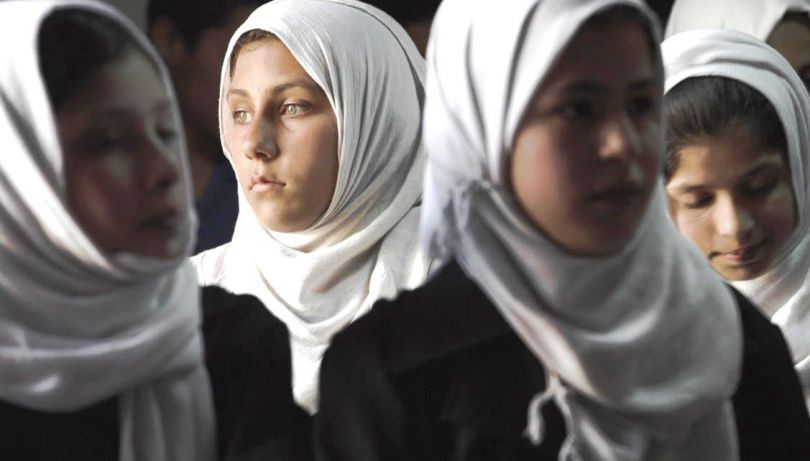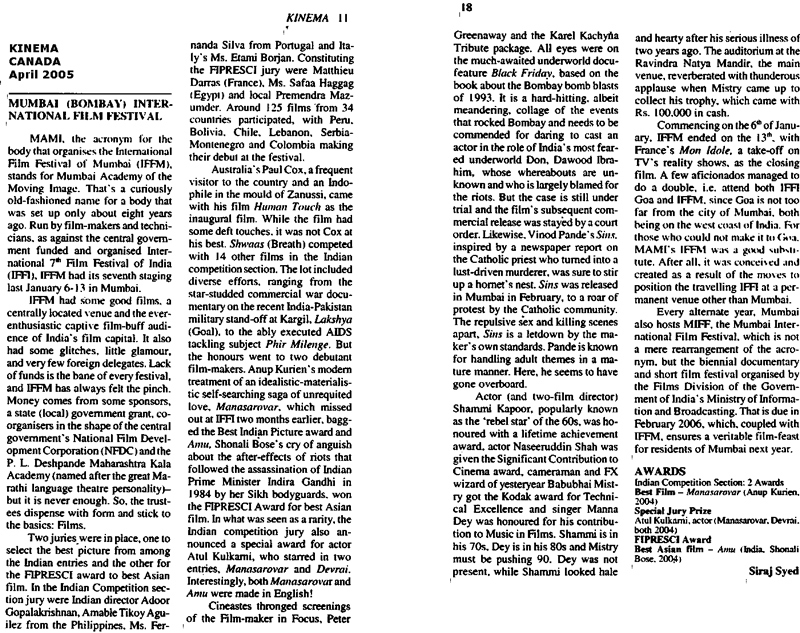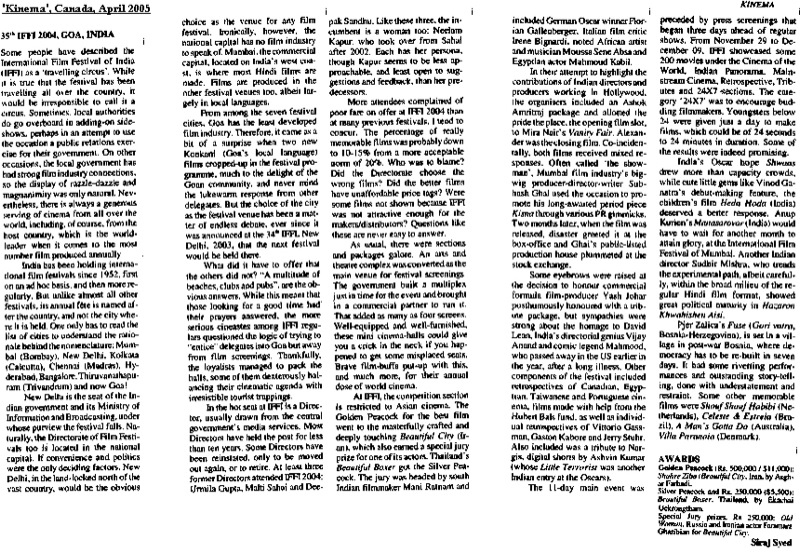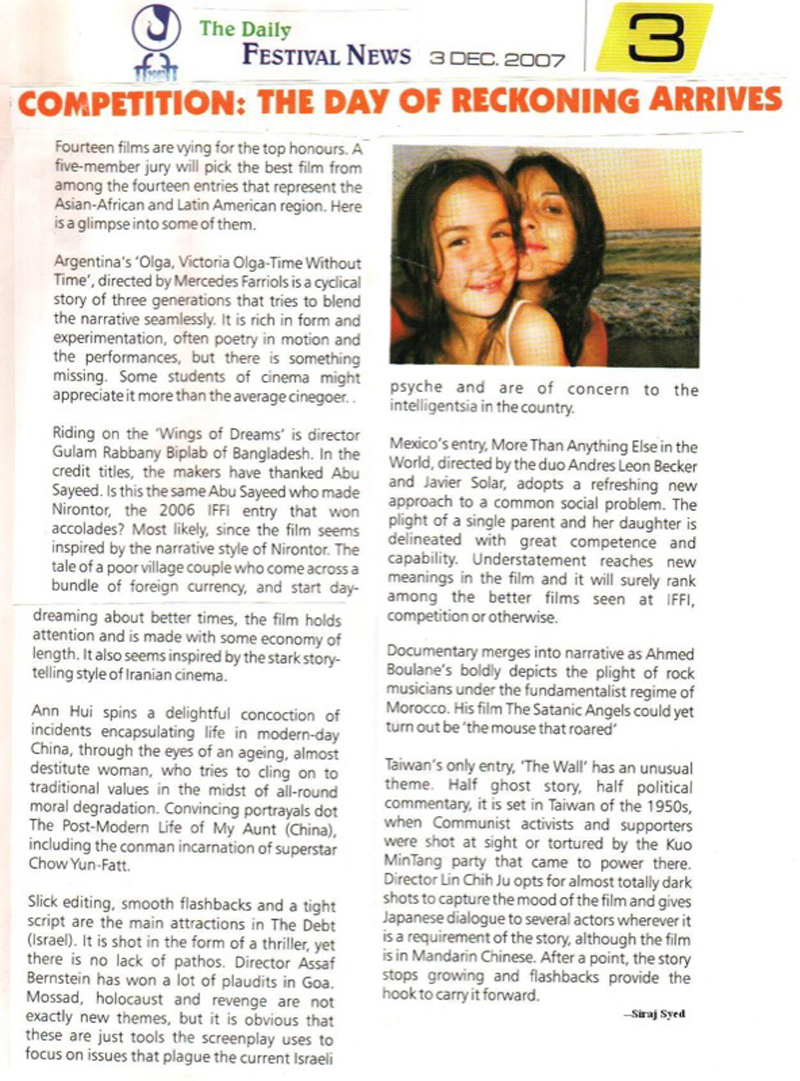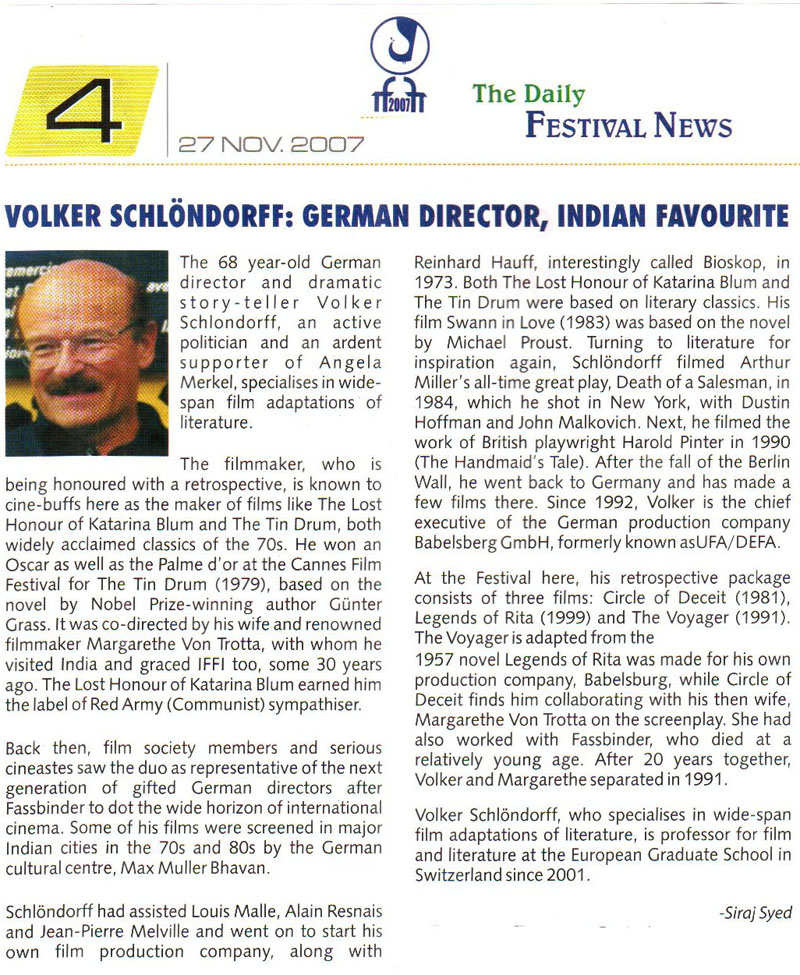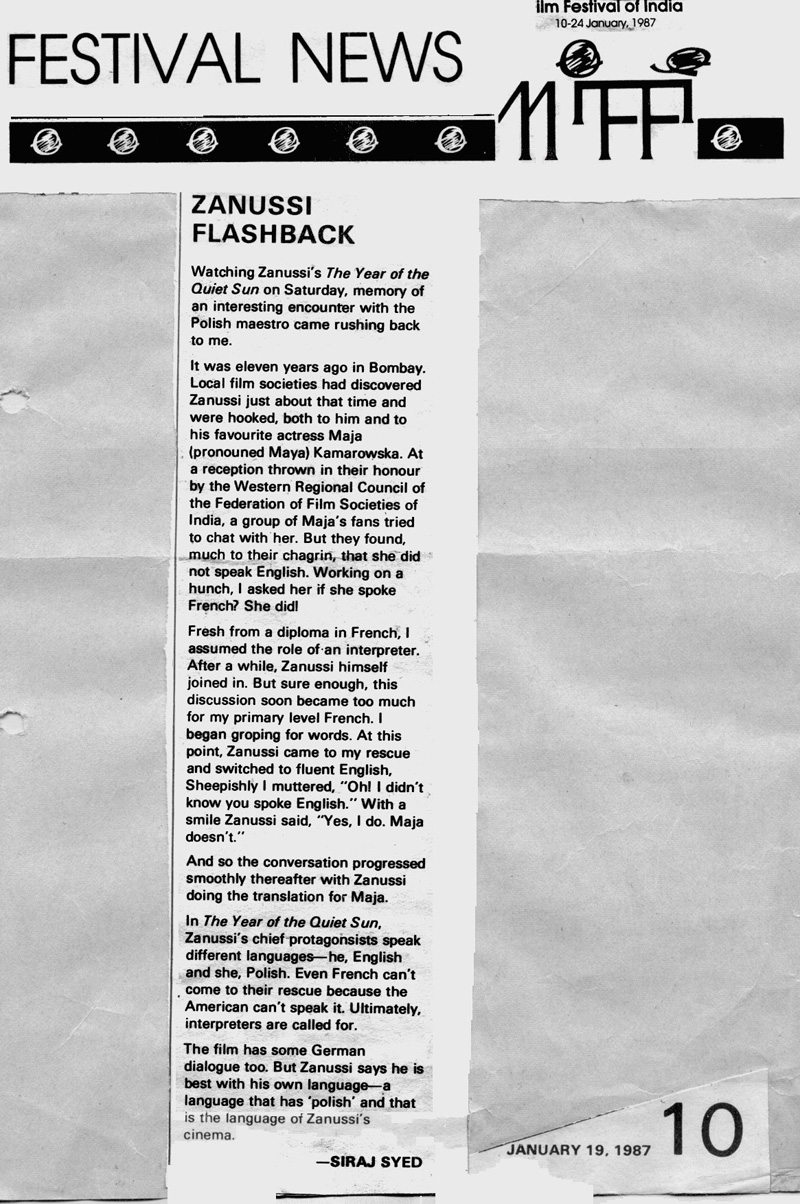|
|
||
|
Pro Tools
FILMFESTIVALS | 24/7 world wide coverageWelcome ! Enjoy the best of both worlds: Film & Festival News, exploring the best of the film festivals community. Launched in 1995, relentlessly connecting films to festivals, documenting and promoting festivals worldwide. Working on an upgrade soon. For collaboration, editorial contributions, or publicity, please send us an email here. User login |
MFF 17, by Jio-MAMI, Festival Diary, IV
MFF 17, by Jio-MAMI, Festival Diary, IV At film festivals, the experience of watching films is like no other. You have many choices, depending on the venue, and the option of walking out of one ‘bad’ film into another unknown entity, just next door, trying pot-luck. Advance booking, the norm at MFF, means that you might never ever succeed in getting a ticket, given that the number of delegates and media-persons always far outweighs the number of seats available, often by 3:1 or 4:1, and the seat goes to whoever hits the mouse or the touch screen first. The only reason one does get some to see some films in the end is the theory of supply and demand. Some films are in great demand, others not so. The latter often play to empty halls, while the former have a serpentine queue of hopefuls, who patiently wait for up to an hour or two, anticipating substantial ‘no show’ turn out. Indeed, there have been occasions in MFF when the capacity was, say 300, the show was ‘sold out’, and yet there were not more than 100 persons in the auditorium at the start of the show, a bonanza for the ‘unreserved’ class, that often included ‘yours truly’. Needless to say, tastes differ dramatically. Some raved films make you wonder how they even made the cut, the odd mouse arrives with a roar, and the rest fill the bill. At any good film festival, more than 20% films rate ***1/2 or above. So-so festivals tip 15%, while if the really watchable film percentage is less than 10, it’s a waste of precious time and precious human resource. MFF 17 was in the 15% category, based on the films I could sit through and those that I had to escape from. I am scanning the catalogue, and recalling the films that I saw at Jio MAMI’s 17th MFF, page-wise/alphabetically.
Un+Une/One Plus One was the much looked forward to film. Since it was directed and co-written by Frenchman Claude Lelouch, whose Un Homme et Une Femme (1966) was successfully remade in Hindi by Ramesh Sippy (who later directed the all time cult classic, Sholay) as Andaz. It was given pride of place, as the closing film, probably because it is set partly in India and the locale of Varanasi (wonder why the other de rigueur foreign film unit favourite, Jaipur, was bypassed!). Carefully characterised and earnestly acted, the film still proved an overall disappointment. It is extremely verbose, and a translucent, clever re-working of Un Homme et Une Femme, exploring relationships between married couples as well as those who play by the ear, making a strong case for ‘opposites attract’. Great music, not so great Indian participation (Rahul Vohra, Shriya Pilgaonkar, Abhisek Krishnan) and just about passable narrative—leads me to give it **1/2. Volcano (Guatemala-France), directed by Jayro Bustamante, was, for me, the mouse that roared. A masterly natural essay about the plight of Red Indians in modern day Gautemala, set against the volcano that separates the country from Mexico, and symbolically holds them back from migration to the USA, the film has mind-boggling performances from actors most probably playing themselves. It won an award, and richly deserved too. Rating: ****
Using minimalist technique, Bi Gan’s Chinese film Kaili Blues about loneliness, family issues and the inevitable modernisation of the countryside, was another surprise packet. It is indulgent, slow and detached, plays around with time and sequential order, but makes a profound impact when you begin to sink into it. Let’s go with ***1/2.
Mina Walking required brave-heart Canadian/Afghan writer-director Yosef Baraki to make it, in guerilla style. Exploding several myths about young girls in present-day Afghanistan (Kabir Khan, you must see Mina Walking!), it uses the milieu of everyday occurrences and a few stereo-types too, assemble a must-watch movie. Acting is a treat to watch. The only minus points would be the constantly jerky, hand-held camera, and the fact that it is shot with one camera, in available light. Considering the genre, one might overlook these shortcomings, and even applaud the feature film of the debutant director, as Mina is Walking tall. Another winner at the festival, it corners ****. For an Iranian film, 105 minutes is considered long. Writer-director Behtash Sanaeeha makes Risk of Acid Rain seem longer. Never judgemental, the film frames the lives of a desolate retired company junior executive based in a province, and his encounters with various individuals in Teheran, whose lives he touches. It’s grim if you go with the protagonist, but optimistic when you peep into the lives of the younger generation of characters, who go with the flow. Amazing that even a somewhat disappointing Iranian film manages ***. Blame it on the hype, if you like. Ram Reddy’s Thithi, touted by some as the best Indian film a decade, is not even the best Indian film in month. It gets off to a good, humorous start, and then peters out into the kind of matrix that looked really hilarious in the comedy fest, Maalaamaal Weekly, but seems completely out of place in a film that apparently deals with the more contemplative side of village life, using sarcasm rather than slapstick. To add to my woes, the air-conditioning failed in this show, and a seat below the hot air-duct, in a packed house, was not the ideal place to watch Thithi from. All attempts to get the A/C functioning, or finding another seat, failed, and I missed some 20 minutes of the film in the process. No rating, though I was told that the film catches on in the second half, but ratings cannot be based on hearsay. And, yes, it did win a prize. Let’s move on now from the Competition Section to the India Gold section. A few minutes into Chauthi Koot (India, Gurvinder Singh), I could not help feeling I was watching Anhey Ghorhey Da Daan (2011). Later, I read that CK was the second feature of Gurvinder, who had made AGDD. A huge Mani Kaul disciple, he had made the earlier film under Kaul’s guidance, but Kaul died before it could get completed. There is a lot of Kaul in both films. Both are shot mainly outdoors, in low, available light, both brood and brood, characters in both films take long pauses before speaking, probably in an attempt to let the painting like ambience sink in, and both films convey very little through dialogue. In Chauthi Koot, the backdrop is the high level of mistrust between Hindus and Sikhs, following the Khalistan agitation of the 1980s, the killing of a Sikh Guru and his followers in a military operation and the assassination of India’s Prime Minister by her two Sikh body-guards. It is slightly easier on the senses than AGDD, but the extensive footage devoted to a dog detracts from the social commentary that the film sets about to make. Rather late into the film, I made my way towards the ‘paanchveen koot’ (fifth direction), the exit. Unless some magic surfaced in the final moments, the award it bagged must have been for the vast gaps in comprehension that audiences find themselves facing when viewing deeply indulgent cinema. There’s more to say. But with the International Film Festival of India (IFFI) coming up in Goa, in a couple of days, we’ll have to wait. 17.11.2015 | Siraj Syed's blog Cat. : Afghanistan Andaz Behtash Sanaeeha Chauthi Koot Claude Lelouch Ixcanul Jayro Bustamante Mani Kaul Mina Walking Ramesh Sippy Risk of Acid rain Sholay Un homme et une femme Un+Une Volcano Yosef Baraki FESTIVALS
|
LinksThe Bulletin Board > The Bulletin Board Blog Following News Interview with EFM (Berlin) Director
Interview with IFTA Chairman (AFM)
Interview with Cannes Marche du Film Director
Filmfestivals.com dailies live coverage from > Live from India
Useful links for the indies: > Big files transfer
+ SUBSCRIBE to the weekly Newsletter Deals+ Special offers and discounts from filmfestivals.com Selected fun offers
> Bonus Casino
User imagesAbout Siraj Syed Syed Siraj Syed Siraj (Siraj Associates) Siraj Syed is a film-critic since 1970 and a Former President of the Freelance Film Journalists' Combine of India.He is the India Correspondent of FilmFestivals.com and a member of FIPRESCI, the international Federation of Film Critics, Munich, GermanySiraj Syed has contributed over 1,015 articles on cinema, international film festivals, conventions, exhibitions, etc., most recently, at IFFI (Goa), MIFF (Mumbai), MFF/MAMI (Mumbai) and CommunicAsia (Singapore). He often edits film festival daily bulletins.He is also an actor and a dubbing artiste. Further, he has been teaching media, acting and dubbing at over 30 institutes in India and Singapore, since 1984.View my profile Send me a message The EditorUser contributions |

















